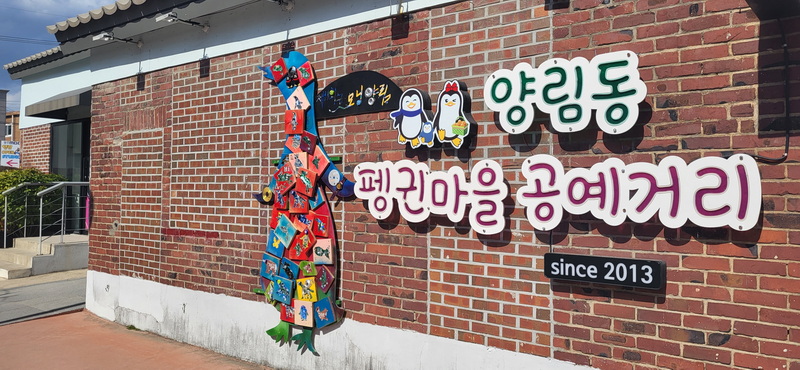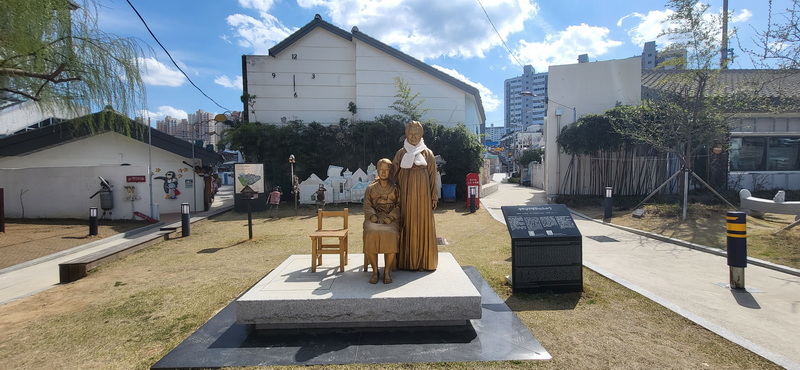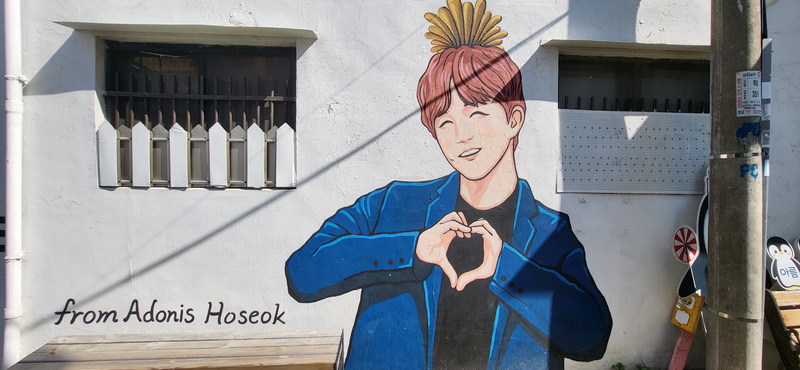A Return to the Past: Penguin Village, Yangnim-dong
By Ophélie Papier

2023, 2013, 1980, 1970… As soon as you enter Penguin Village, the clock begins to turn backwards. From the beginning to the end of your visit, it feels that the present and the past blend together. If you have ever dreamed of having a time machine, you can always come here. Although there is no time machine, all you need is a camera for fun photos. Penguin Village in Yangnim-dong, Gwangju, is a lovely and amusing place to visit for all ages, with friends, family, or alone.
The Village is located in Yangnim-dong, Gwangju, Jeollanam-do, between two subway stations, the Culture Complex and Namgwangju.
It is in the region of the outer wall of the former Gwangju Town Castle and was once called the “Western Village.” At the beginning of the 20th century, missionaries came to settle in the area, such as Eugene Bell (1868–1925), who was a missionary sent by the Southern Presbyterian Church to spread Christianity. That is why there are many missionary houses there. Also, traditional and Western culture are fused, producing many cultural artists. Penguin Village is an attraction of the area that has become a popular spot in Gwangju.

Why Is the Name “Penguin Village”?
The Village has no penguins, but the name was conferred after a fire broke out in 2013. Because of the damage caused by the fire, the neighborhood fell into disarray due to the accumulation of rubbish. Kim Dong-gyun, the neighborhood head, took the initiative to clean up the neighborhood with the help of locals. He began to decorate the area as a hobby with all sorts of old objects and odd debris found piled up in a vacant neighborhood. It is said that he cultivated a vegetable garden with the villagers, and the different crops were shared with them. From here, they gave him the nickname “Penguin” because he was short, cute, and curvy like a penguin. This is why the neighborhood residents affectionately named it “Penguin Village.”

A Village Full of Symbols
At the entrance to the Village, it is impossible to miss the beautiful statue of Lee Ok-seon. Born in Busan, she is a symbolic figure representing the “comfort women” victims of the imperial Japanese Army. Madame Lee had been forcibly taken to a brothel in Manchuria, China, when she was just 16. Returning to her native country after the liberation of Korea from Japanese colonization, she worked to increase awareness of her sad past and to ask for an official apology from Japan. The statue symbolizes Lee at both the age of 16 and 92. Unfortunately, she passed away on December 26, 2022, aged 94. Her funeral took place in Gwangju.
Right next to the statue, there is a large, old weeping willow tree. Since the middle of the Joseon Dynasty (1550–1700), there have been many weeping willows in Yangnim-dong, however, over time, they have all disappeared due to heavy construction work. This one was planted in 1943 but was uprooted due to a typhoon on October 3, 2015. It was moved to its present location on October 7, 2015, and symbolizes the origin of Yangnim-dong.

An Artistic Village Full of Color and Poetry
Once we step into the Village, we sense a riot of color through its vintage arts center that attracts a lot of tourists. There is a collection of old watches, clocks, cameras, radios, CDs, tools, plushies and many other items from the 70s and 80s. Naturally, there are cute penguins everywhere, but also an accumulation of recycled objects and other paraphernalia. A second life is given to these objects, which transform the alleys of this district into an open-air museum.
We can appreciate the rather nice murals and drawings, not only of penguins but also the following: a painting of the “Little Prince” from the popular French fairy tale, drawings of our favorite characters, and at the end of the village, there is a giant mural of J-Hope from the BTS boy group. It was created and sponsored by J-Hope’s Chinese fans to commemorate J-Hope’s birthday, who is himself from Gwangju.
If you like poetry and can understand Korean, the village is full of poems written all over the walls to cheer you up.
What Not to Miss in the Village
There may be nothing better than taking a walk with a snack or a drink, right? Here there is everything you need. Right next to J-Hope’s mural, there is a takeaway café. You can find adorable manjoo (만주), a typical Korean choux bun with cream in the shape of a penguin. They also provide a wide range of beverages in a cute penguin cup.
At the exit, there is a large stand with a selection of candies and snacks. Here you can find multicolored lollipops and other sweets that reminded me so much of my childhood.
Also, in the middle of the Penguin Village, there is a moon on a roof that creates an illusion of standing next to the moon. It is a perfect place to take photos and enjoy the view of Gwangju. When we look at the view, we notice in the distance a large, reddish building which is the Yangnim Church, built in 1954 in the style of an old European church complete with church bells.
Finally, the last place you should visit is the “Penguin Tavern” located in the center, where all the neighborhood residents meet up to discuss events and the future of the Village. If you are lucky, you will see some of them there.
Sources
Korea Herald. (2012, November 30). Linton family has century-old history of service to Korea. https://www.koreaherald.com/view.php?ud=20121130000825
Calpo, L. (2023, January 6). Exploring Korea’s past in Gwangju’s Penguin Village. Korea.net. https://www.korea.net/NewsFocus/HonoraryReporters/view?articleId=227976
KBS World. (2022, December 27). Victim of Japan’s wartime atrocities, Lee Ok-Sun, dies aged 94. http://world.kbs.co.kr/service/news_view.htm?lang=e&Seq_Code=174766
Kim, D. (2022, November 5). The rooms of the surviving “comfort women” – Lee Ok-sun’s room. Kyeol. https://kyeol.kr/en/node/221



